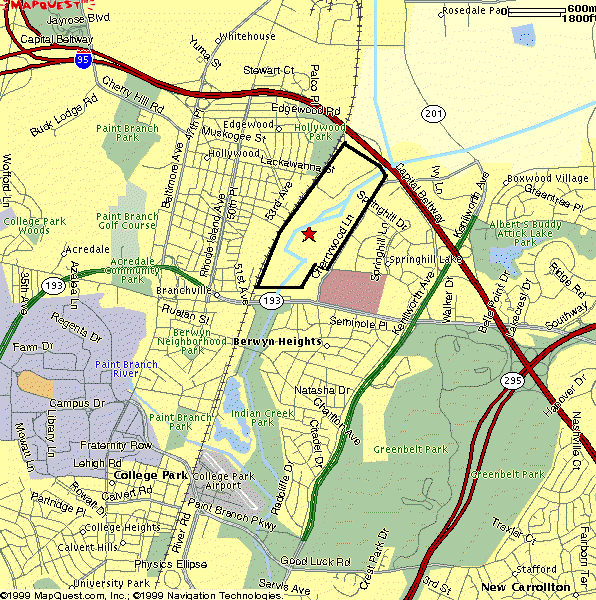|
The site of the proposed development at the Greenbelt Metro station
The Indian Creek valley south of the Washington Beltway and adjacent to
and south of the Greenbelt Metro station
is one of the last natural floodplains inside the Beltway.
This portion of Indian Creek is the sole remaining unchannelized
portion of the stream valley within the Beltway.
This natural stream valley is threatened by the proposed development of a
large shopping mall on properties currently owned by WMATA and
A.H. Smith. The site, a total of 240 acres
including 128 acres consisting of wetlands, forested flood plain and upland forest,
is enclosed by Cherrywood Lane on the east,
the Beltway on the north, the MARC/Metro
railroad tracks on the west and
Greenbelt Road (MD Route 193) on the south.
More detailed information about the site and its natural beauties
can be found in
Kate Spencer's article in the Audubon Naturalist News
(Dec. 1998).
|

Click the image to get enlargement
|
Current use of the site
The notheastern portion of the site hosts a commuter parking lot for the
Greenbelt Metro station
in the north (some 40 acres). The southern part hosts industry,
consisting mainly of a gravel pit with a construction waste dump site.
The operator, A.H. Smith, has filled portions of the floodplain and
wetland in the southern part of the site.
The heart of the property is a wetland
harboring many species of rare
plants (e.g. swamp chestnut oaks, cattail sedge, bog chickweed) and
providing essential refuge for wildlife in this
suburban environment. The existing wetland of 128
acres constitutes
the 100-year floodplain of Indian Creek, a
tributary of Paint Branch within the Anacostia Watershed.
The floodplain is essential for stormwater control
for the downstream communities Berwyn Heights and Riverdale.
|
What is being planned?
Metroland, a joint enterprise involving WMATA
and A.H. Smith and others, plan to construct an
upscale retail mall (to include one high-quality
retail store), office space, and a retirement community.
Although now modified (see below), initial plans called for elimination of
the stream valley and creation of a suburban park with an artificial lake
and paved riverbank trails.
The stream valley will be eliminaed, and the developer plans a
suburban park with an artificial lake and paved riverbank trails.
The developers are seeking another full interchange on the
Beltway between I-95 and Kenilworth Avenue to accommodate the expected
traffic and a connector road to Greenbelt Road. This development is expected
to generate 90,000 car and truck trips a week by 2012. Full development is
not expected to be completed until at least 2020.
The development as now planned for the northern portion of the property,
directly off the beltway and on the Metro Station parking lot, calls for office,
hotel, very little residential, and an enclosed regional shopping mall. The
southern portion, the gravel mine operations, is slated to be a mix of apartments,
condos, townhouses, senior housing, office and more retail.
There is no housing planned within convenient walking distance of the Metro station
(within a quarter mile).
|
Current legal state of affairs:
The County Council in June 1998 passed CB-35, an law that bypasses
zoning procedures
to allow this specific site (currently zoned heavy industrial)
to be developed into a shopping mall, office space, and
residential community if a so called upscale) retailer
signs a letter of intent to establish a store within the mall.
In turn specific (discount) retailers are banned from the proposed mall.
Subsequent county legislation superseded a sector plan developed with
intense public participation that had specified a town center development
rather than an enclosed mall.
At the urging of the City of Greenbelt, CCRIC and allies, the Governor agreed,
in late 2000, to purchase the core 75 acres of upland forest, wetlands and
floodplain forest, provided Metroland donated an additional 36 acres.
Despite two years of community meetings and hearings at which objections and
concerns were expressed by CCRIC and residents of Greenbelt and surrounding
communities, the Prince George's County District Council approved, in September
2001, the preliminary development plans of Metroland.
The City of Greenbelt and Quantum Management, owner of Beltway Plaza Mall, have
brought suit against Metroland about the legality of their conceptual site plans.
The court judge ruled in June of 2003 that the plan was legal
but the City of Greenbelt immediately appealed so things are
still on hold as of Jan. 2004.
The proposed mall is designed to attract wealthy shoppers to Prince George's County.
Most of these shoppers would be drawn from Montgomery and Howard Counties
to boost tax revenue and employ Prince George's County residents, but ...
|
Who would reject a retail place with up-scale retailers in his
neighborhood? |
We do!
Environmental concerns
Another shopping mall unnecessarily increases congestion in our part of
the county (if it is actually successful). The mall and its Beltway access
will encourage people to travel across the county to shop instead of patronizing
malls near their homes.
Roads that are already at capacity, like Greenbelt Road and the Beltway,
will become even more congested.
Besides the mall (which will not be restricted to the current Metro
parking lot), an extensive residential community and large office buildings
are planned for this sensitive stream and floodplain.
The plans also call for development on the wetland mitigation site on the property.
This site was to replace 4.5 acres of wetland destroyed in building the Metro station.
Building on this site will cut off the path that the Sptted Salamander uses to reach
the only vernal pool we know to exist on the property. They use of this pool for
mating and as a nursery. This pool is also used by the frogs that live on the site.
Now, roads will connect this new isolated development to the
"rest of the world," mainly by a new Beltway interchange and a connector
road running the length of the property south to Greenbelt Road
to meet federal highway regulations (i.e., no Interstate interchange may
serve only private property).
Metrolands proposal will significantly impact the valuable natural habitat still
found in the property. The replacement of considerablen Indian Creek floodplain,
30+ acres, will threaten homes in downstream communities because heavy rain and
runoff will no longer be moderated by the now-existing Indian Creek
floodplain.
| |
The building on the mitigation site and the connector road will fragment the
forest on the property and further diminish the quality of life located there.
There are known polpulations of deer, foxes, frogs, salamanders, turtles, beaver,
and numerous species of birds.
There have been over 100 species of birds sighted on this property.
Economic and Social concerns:
People from all of Prince George's County are expected to come to the mall.
Added congestion will bring more noise and possibly more crime, especially in the
vicinity of the struggling Springhill Lake community.
Other malls in the vicinity will further decline
(Beltway Plaza Mall, only a mile away) as patronage of local malls near
people's homes will decline. Westfields, the current developer under contract with
Metroland LLC, has made it clear that it will have no problam putting Beltway Plaza
out of business or for that matter other neighboring businesses.
The "downscaling" of local malls is the more unwelcome addition to the
proposed "up-scale" mall.
The mall will create another "island" of development
connected to the "rest of he world" only by new
roads engendering more isolation.
The developer's proposal suggests that the development will generate
8000 new motor vehicle trips per day and that 90% of the patronage of the
new development will be from motor vehicles.
The scope of this development along with the new IKEA on Route 1 will turn the
Beltway and our neighborhood streets into parking lots.
There is no assurance that the promised upscale development will occur.
Predicted upscale development at other locations in the county has failed to
materialize.
|
Governor Parris Glendening's Smart Growth
policy and related legislation call for concentrating development around
existing infrastructure like Metro stations, but also mandate preserving
streams and ecologically sensitive areas.
We want Smart Growth, including:
Conservation of remaining open spaces such as parks, forests, and rivers
with their floodplains.
Concentration of development on already used land (land recycling).
Pedestrian-friendly city centers and shorter
distances between workplaces and residential communities.
Effective public transportation system for the
suburban Baltimore-Washington area on 7 days a week,
365 days per year.
Rehabilitation or re-establishment of city
centers, proper road maintenance, and reduction of eyesores such as
billboards.
Rehabilitation of strip malls by construction of roadside store-fronts
with complete sidewalk networks connecting to adjacent residential communities.
Transit-oriented development with housing concentrated within a quarter
mile of a Metro station.
Unwise Growth includes:
Building shopping malls in the vicinity of declining or
half-empty existing malls.
Creating new isolated subdivisions to be accessed predominantly
by automobile.
Devouring our few remaining natural habitats thoughtlessly in
overdevelopment that does nothing more than increase the density of paved
land without in fact serving the community.
CCRIC homepage
|



